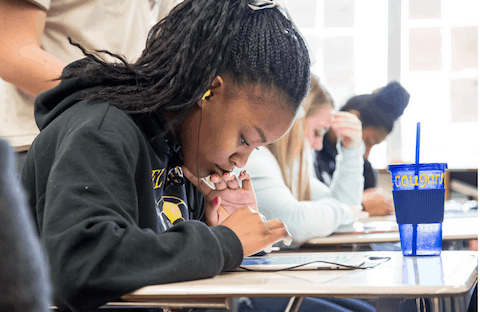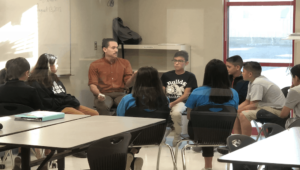Connecting Learning and Life: Naviance

Ever heard a student ask the question “When will I use what I’m learning in this class in my future?” While students may not be able to answer that question every lesson, every day, they should have a general sense of how learning connects to life. As we seek to further personalize learning, a very important piece of the puzzle is a student guidance system that helps students to draw connections between current learning and future life goals and plans. In fact, student guidance will be the focus of a Smart Series paper that will soon be released by Digital Learning Now! and Getting Smart. Specifically, the paper will explore how we can provide a more personalized, blended and distributed guidance model for all students. Such a model will require an increase in the use of tools like Naviance that will help students make informed decisions about college and career plans and, as Naviance asserts, “connect learning and life.”
Naviance is a college and career readiness platform that helps connect academic achievement to post-secondary goals. It does so by connecting multiple facets of the guidance process:
Connecting Learning. Naviance uses a comprehensive platform (web-based and device-friendly) that connects learning to life by addressing four key areas of college and career readiness: self-discovery, career exploration, academic planning, and college and career preparation. Their new student app helps students manage tasks, search for colleges, plan for college visits, and see how these four key areas connect together.
Connecting People. It’s tough for students to navigate future planning alone. Naviance leverages technology to ensure parents, adult advocates and students are all on the same page. Dan Obregon, Vice President of Product Management and Marketing, states, “We continue to ask ourselves not only how to provide students with meaningful and engaging tools that capture their goals and plans, but also how we can provide educators and adult advocates with actionable data about student performance, so they can in turn deliver better guidance.”
Connecting Processes. While Naviance began primarily as a counselor tool to manage the college admissions process, it has evolved to address multiple functions of guidance. For example, Naviance has long supported college and career guidance functions through its portal by offering easy college research tools. Colleges can be matched and filtered based on career interest, geography, size of school, selectivity, available majors and more. There is a scatterplot feature that helps students see how they stack up in terms of GPA and test scores with other students from their high school admitted to various institutions. Further, Naviance is connecting college planning to what students are doing in middle schools and high schools.
Connecting Present and Future Plans: Naviance Course Planner supports the function of middle and high school course planning to develop individualized learning plans and meet graduation requirements. It includes a “Step Up” prompt for students who may – based on prior course enrollment and performance – suggest a more rigorous class. Naviance’s eDocs tool is used to send transcripts (parent company Hobson’s recently acquired The National Transcript Center), letters of recommendations and other supporting documentation to colleges.
Connecting Results. An example of how Naviance can contribute to student success can be found in Minneapolis Public Schools (MPS), where they recently reported great boosts in plans, graduation rates, and college enrollment. Since MPS started using the product, MPS has seen an increase of 30 percent in the number of students who have postsecondary education and career plans, and the number of students attending a four-year college has increased by 6 percent. Additionally, a recent graduating class showed an improvement of 15 percent more students going to college compared to the previous year.
The connections will continue to grow. In the spring of 2014, Naviance is launching a new curriculum which – in addition to college and career guidance – focuses on helping students develop an academic mindset (as well as social emotional learning and financial awareness) and start to make connections between what they’re doing in the classroom and what they aspire to do in life after school.
So, the next time a student asks, “When will I ever use Geometry in my future?”, hopefully we can help that student see how completing this course helps him or her achieve future goals (and maybe, just maybe, that student is aspiring to be an architect and the content connections will be easy to see!)






0 Comments
Leave a Comment
Your email address will not be published. All fields are required.